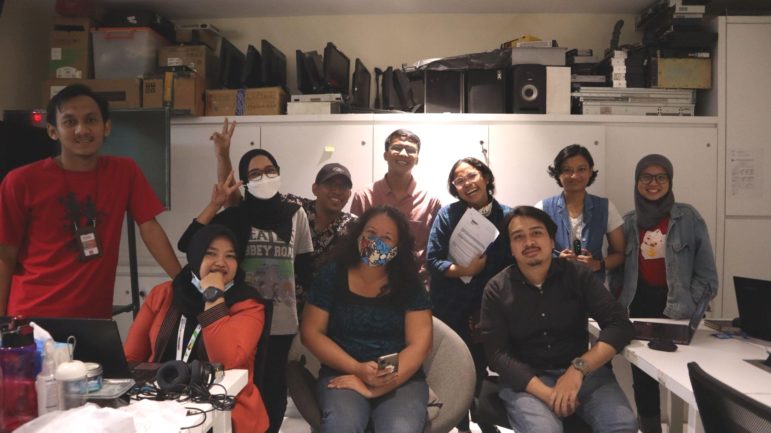

How Women Are Driving a Golden Age of Data Journalism in Kenya
Eunice Magwambo, Purity Mukami, and Juliet Atellah discuss their work and the challenges faced by data journalists in their native country, Kenya.
Data journalist Eunice Magwambo has seen a seismic change in the attitudes of her Kenyan colleagues towards data journalism. When she arrived in the news industry in 2018, most Kenyan journalists shied away from this discipline as they thought it was a preserve of people with IT skills.
As they received training, this perception began to shift. “They’ve realized that data journalism is a pipeline of how an idea is researched, thought out, and presented as news,” she says.

Eunice Magwambo’s team has trained more than 2,000 local journalists in data visualization. Image: Screenshot, Eunice Magwambo InvisionApp
Magwambo, whose team has trained more than 2,000 local journalists on this discipline, is a specialist in data visualization. Some of her projects include pieces about why rural women and children fetch water for long distances, human and sex trafficking, stillbirths in Kenya, and Uganda teen pregnancy.
As a practicing journalist, she has witnessed a new appetite for data-driven stories in her home country. “You can produce a two-page, well-researched piece, but a section of the audience will find it difficult to understand,” she says. “As a journalist, you intend to reach out to everybody. That is why data visualization is important, so even the least informed part of the audience can absorb information.”
Audiences are Ready
This hunger for data-driven stories has attracted investment from newsrooms. Infographics and data visualization get shared widely on digital platforms and especially on WhatsApp, a messaging app that 61% of young, more urban Kenyans use for news, according to the figures in the Reuters Institute’s Digital News Report 2022.
One of those stories is The Kiss of Poverty That Drained Man’s 700,000 Shillings Within a Week (about US$6,000), a visualization about how a 60-year-old man lost a big amount of money he had earned from selling his property. Another was Deadly Force, a visual project about police brutality in Kenya. Although there had been several reports on police violence before, this visualization gave the subject the attention it deserved and made it a topic of public concern. Both visualizations went viral across multiple social media platforms. For instance, on Facebook, the poverty post had over 250 comments and 22 shares, and, on Twitter, close to 215 Retweets and nearly 1,500 likes. Visualizations made many more rounds on WhatsApp groups.
Several newsrooms in Kenya have embraced the use of data to help understand the stories they are covering. Initially, journalists would report court cases and press conferences as they happened. Today journalists use data to investigate, elaborate, and give a broader understanding of whatever issue is at hand.
Data journalism is also changing the way statistics are reported. On the national budget day, for example, journalists used to give figures without any context and just as they were announced by the Finance Minister. Today they contextualize them and try to explain what they mean to citizens’ lives.
“We are training entire newsrooms,” Magwambo says. “When we did it for Citizen TV, they seemed to think that this was a first in the media. There was curiosity about what this was, if media outlets did it, and how they could incorporate it into their stories.”
Kenyan newsrooms that have a dedicated data journalism desk include Nation Media’s Newsplex, which was among the first in the country; Standard Group’s Checkpoint; Business Daily, which has a dedicated Instagram account for data visualizations; and The Star Kenya, which has a dedicated page for infographics. As for new media platforms, not only have they incorporated data-driven content, but have also published some incredibly inventive and interactive stories.
These include Surviving Kenya: the Crisis of Kenya’s Unemployed Youth, an interactive about unemployment in Kenya produced by Debunk Media; Mapping the Coronavirus Pandemic in Africa, a live data visualization of the coronavirus spread in Africa by The Elephant; and Wizileaks, an interactive data visualization that aggregates corruption and graft-related data from Kenya’s various administrations since 1978 by Africa Uncensored.
From a Twitter Thread to Investigative Journalism
For Purity Mukami, a senior data reporter at Finance Uncovered, a Twitter thread was the entry point into the world of data journalism. It was in August 2017 during Kenya’s general election, the first one whose results were live-streamed from over 40,000 polling stations and made available to the public through the election body’s website. Purity started sampling some of the results to predict who would win and also see how election rigging could be spotted in case it happened.
“I was sampling them and posting them online with comments pointing at things from that pool of documents. That’s how [Africa Uncensored co-founder] John-Allan Namu spotted my tweets and reached out to ask if we could collaborate and do the same to monitor the entire elections,” she says.
She joined Africa Uncensored and audited all 40,000 forms from polling stations. The data they collected informed the documentary “In Tribe we Trust,” looking into the issue of Kenya’s political division along tribal lines.
Mukami notes that she has witnessed a change in newsrooms and how they treat data journalism. When she joined in 2017, her role was not defined, and editors did not know what assignments to give her. “At first colleagues were not even sure what name to give me,” she says. “They didn’t know whether to call me a data expert, a data reporter, a data producer or a data editor. Now there is awareness and clarity on our role.”
She also notes that data journalism has also created an environment for collaboration among journalists.
Purity is a trained statistician and uses her statistical skills to support “follow the money” kind of investigations. She has worked on some of the groundbreaking, data-driven stories published in Africa. These include The Troubled Suspected COVID-19 Intermediary Host about pangolins, the world’s most trafficked mammals; Client 13173: The Secret Offshore World of the Kenyatta Family, part of the Pandora Papers about offshore companies and foundations connected to the then-Kenyan president’s family; Kenya: Institutionalised Theft and the High Cost of ‘Budgeted Corruption,’ an investigation from leaked data that exposed loopholes in Kenya’s procurement enabling corruption; and Captured: Stella’s Web, a documentary on companies perpetrating massive fraud in government procurement. The latter was based on leaked documents and publicly available data.
Many Newsrooms Still Lack the Expertise
Even though journalists have made strides in data journalism, there is still more to be done. Mukami says very few journalists have developed the skills to interact with data and to find information in a given dataset. “If you want to hire a data journalist in Kenya today, not many people will come to mind,” she says. “The same can’t be said when you want to hire a producer or writer.”
Additionally, there needs to be more capacity building and strengthening of the data desk in newsrooms. According to Juliet Atellah, a data and investigative journalist, most newsrooms are yet to establish a team that works on data stories. The work is left to an individual who is expected to scrape the data, analyze it, write a story out of that data, and visualize it. In some cases, she says, newsrooms employ an intern to assist the journalist.
Atellah is currently a consultant at The Elephant and a research fellow at OCCRP. Some of her stories include Counting the Dead: Suicide Rates in Kenya (2006 – 2017), a data analysis story on the rising cases of suicides in Kenya; Follow the Money: Is There a Role for Cash Transfers in Climate Change Adaptation?, a project about the corruption risks associated with funding aimed at assisting poor people affected by climate change; and Things Are Elephant: The Effect of COVID-19 in Nairobi Low-Income Areas, about the extent of the impact of the coronavirus crisis in Nairobi’s low-income areas. The latter two were collaborations with Eunice Magwambo, who designed the data visualization.
Atellah trains journalists on open source intelligence tools, the use of data storytelling, and the use of data in investigative storytelling. In her classes, she always emphasizes to journalists that data is not just numbers, rows, and columns. Data can also be words, conversations on Twitter, government records, leaked documents, and more. “For instance, I can analyze information about a former president by just searching specific words they posted on Twitter,” she says. “I can scrape the data, analyze whatever information I want from tweets posted, and get a story out of it.”
Key Challenges
One of the major challenges Kenyan data journalists face is that most of the data they need is documented in analog formats. Sometimes they are forced to deal with data that is handwritten in a book, sometimes unintelligible, or missing some key information due to a torn page. Sometimes key information is stored in different books and one has to go back and forth to make sense of the information therein. Mukami says this is a challenge that journalists can resolve with training programs that are tailor-made for this kind of scenario, which is common in Africa. She thinks journalism schools in Kenya should also incorporate master’s degrees in data journalism to enable graduates to come out with these skills. At the moment, data journalism is taught as a unit in a single or two semesters in undergraduate courses.
The other big challenge facing Kenyan data journalists is access to information. Even though it’s a right enshrined by the country’s constitution, some departments and public officials still do not offer information to journalists when requested. It might take months for them to respond to Freedom of Information requests.
Additionally, there’s a gap in most data stories between the information shown and how it relates to people’s lives. Mukami suggests that most of the data stories in Kenya today appeal to a certain audience. “Data stories are packaged for elite audiences and male audiences,” she says. “They don’t have the emotion to appeal to less educated audiences.” She says that journalists should start making the stories more relatable to these wider audiences.
Despite the challenges that data journalism faces in Kenya, journalists and newsrooms have made significant progress in the field. “We are on the right path,” Atellah says. “Understanding audiences is key. Knowing how to go in-depth, and not just throwing numbers is also important. You should ask yourself: how do you get a story that your audience will read or watch and go back to later because it captivated them?”
This post was originally published by the Reuters Institute and is reprinted here with permission.
Additional Resources
Editor’s Pick: 2022’s Best Investigative Stories from Sub-Saharan Africa
In Kenya, NGOs Bet on Investigative Journalism to Boost Transparency
Fifty Years of Journalism and Data: A Brief History
 Maurice Oniang’o is a versatile freelance multimedia journalist and documentary filmmaker based in Nairobi, Kenya. He has written for National Geographic, GIJN, 100 Reporters, Africa.com, and Transparency International, among others.
Maurice Oniang’o is a versatile freelance multimedia journalist and documentary filmmaker based in Nairobi, Kenya. He has written for National Geographic, GIJN, 100 Reporters, Africa.com, and Transparency International, among others.











